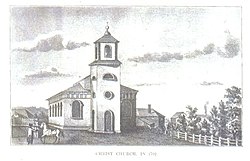Christ Church, Cambridge
|
Christ Church
|
|

Christ Church in 1792.
|
|
| Location | Garden Street, Cambridge, Massachusetts |
|---|---|
| Coordinates | 42°22′30.95″N 71°7′16.09″W / 42.3752639°N 71.1211361°WCoordinates: 42°22′30.95″N 71°7′16.09″W / 42.3752639°N 71.1211361°W |
| Area | 0.5-acre (2,000 m2) |
| Built | 1761 |
| Architect | Harrison,Peter |
| Part of | Cambridge Common Historic District (#73000281) |
| NRHP Reference # | 66000140 |
| Significant dates | |
| Added to NRHP | October 15, 1966 |
| Designated NHL | October 9, 1960 |
| Designated CP | April 13, 1973 |
For other churches with this name, please see
Christ Church, at Zero Garden Street in Cambridge, Massachusetts, U.S., is a parish of the Episcopal Diocese of Massachusetts. Built in 1760-61, it was designated a National Historic Landmark as one of the few buildings unambiguously attributable to Peter Harrison, the first formally trained architect to work in the British colonies.
The congregation was founded in 1759 by members of the King's Chapel who lived in Cambridge to have a church closer to their homes and to provide Church of England services to students at Harvard College across Cambridge Common. The church's first rector was East Apthorp, and most of the founding members lived along the nearby Tory Row, now called Brattle Street.
The church was designed by noted colonial era architect Peter Harrison, who also designed the King's Chapel in Boston, and is one of a small number of surviving buildings attributable to him. Its wooden frame rests on a granite foundation built from ballast stones from ships arriving at Boston Harbor. The church was originally finished in a sanded paint treatment to give the appearance of a traditional English stone church.
During the American Revolution Christ Church was attacked by dissenting colonials for its Tory leanings, but it was also the site of a prayer service which George and Martha Washington attended while quartered in the nearby mansion now known as Longfellow House–Washington's Headquarters National Historic Site. The church was closed, and its organ melted down for bullets during the Revolution.
...
Wikipedia


